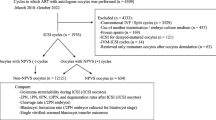Abstract
Purpose
The significance of finding a fragmented first polar body in an oocyte prepared for ICSI is controversial with most recent publications suggesting that it is not prognostic for oocyte fertilization or embryo development. Our purpose was to look at this question in the context of oocytes not stimulated for conventional IVF.
Methods
Oocytes obtained for IVM and obtained from follicles at most 12 mm in diameter were evaluated for their polar body morphology soon after they entered metaphase II when they were denuded in preparation for ICSI. Records were evaluated retrospectively for the fertilization rate and the embryo growth rate (cell number) on each day of development for embryos with normal appearing polar bodies or fragmented polar bodies, but no other cytoplasmic dysmorphisms.
Results
Oocytes with fragmented polar bodies were significantly less likely to fertilize than oocytes with normal appearing polar bodies (p < 0.0001). Embryos which developed from oocytes with fragmented polar bodies had significantly impaired growth compared to embryos that developed from oocytes with normal appearing polar bodies (p = 0.0328).
Conclusions
Fragmented polar bodies likely reflect cytoplasmic incompetence.
Similar content being viewed by others
References
Chamayou S, Ragolia C, Alecci C, Storaci G, Maglia E, Russo E, et al. Meiotic spindle presence and oocyte morphology do not predict clinical ICSI outcomes: a study of 967 transferred embryos. Reprod Biomed Online. 2006;13:661–7.
Ciotti PM, Notarangelo L, Morselli-Labate AM, Felletti V, Porcu E, Venturoli S. First polar body morphology before ICSI is not related to embryo quality or pregnancy rate. Hum Reprod. 2004;19:2334–9.
De Santis L, Cino I, Rabellotti E, Calzi F, Persico P, Borini A, et al. Polar body morphology and spindle imaging a predictors of oocyte quality. Reprod Biomed Online. 2005;11:36–42.
Ebner T, Yaman C, Moser M, Sommergruber M, Feichtinger O, Tews G. Prognostic value of first polar body morphology on fertilization rate and embryo quality in intracytoplasmic sperm injection. Hum Reprod. 2000;15:427–30.
Fancosovits P, Zsuzsa, Tothne G, Murber A, Takacs FZ, Papp Z, et al. Correlation between first polar body and further embryo development. Acta Biol Hung. 2006;57:331–8.
Jurema MW, Nogueira D. In vitro maturation of human oocytes for assisted reproduction. Fertil Steril. 2006;86:1277–91.
Loutradis D, Drakakis P, Kallianidis K, Milingos S, Dendrinos S, Michalas S. Oocyte morphology correlates with embryo quality and pregnancy rate after intracytoplasmic sperm injection. Fertil Steril. 1999;72:240–4.
Navarro PA, de Araújo MM, de Araújo CM, Rocha M, dos Reis R, Martins W. Relationship between first polar body morphology before intracytoplasmic sperm injection and fertilization rate, cleavage rate, and embryo quality. Int J Gynaecol Obstet. 2009;104:226–9.
Rienzi L, Ubaldi FM, Iacobelli M, Minasi MG, Romano S, Ferrero S, et al. Significance of metaphase II human oocyte morphology on ICSI outcome. Fertil Steril. 2008;90:1692–700.
Rienzi L, Vajta G, Ubaldi F. Predictive value of oocyte morphology in human IVF: a systematic review of the literature. Hum Reprod Update. 2011;17:34–45.
Verlinsky Y, Lerner S, Illkevitch N, Kuznetsov V, Kuznetsov I, Cieslak J, et al. Is there any predictive value of first polar body morphology for embryo genotype or developmental potential? Reprod Biomed Online. 2003;3:336–41.
**a P. Intracytoplasmic sperm injection: correlation of oocyte grade based on polar body, perivitelline space and cytoplasmic inclusions with fertilization rate and embryo quality. Hum Reprod. 1997;12:1750–5.
Yakin K, Balaban B, Isiklar A, Urman B. Oocyte dysmorphism is not associated with aneuploidy in the develo** embryo. Fertil Steril. 2007;88:811–6.
Author information
Authors and Affiliations
Corresponding author
Additional information
Capsule
In clinical IVM, oocytes with fragmented polar bodies are less likely to fertilize and are less likely to develop into an embryo with a high potential to implant than embryos develo** from oocytes with normal appearing polar bodies.
Rights and permissions
About this article
Cite this article
Rose, B.I., Laky, D. Polar body fragmentation in IVM oocytes is associated with impaired fertilization and embryo development. J Assist Reprod Genet 30, 679–682 (2013). https://doi.org/10.1007/s10815-013-9982-4
Received:
Accepted:
Published:
Issue Date:
DOI: https://doi.org/10.1007/s10815-013-9982-4




